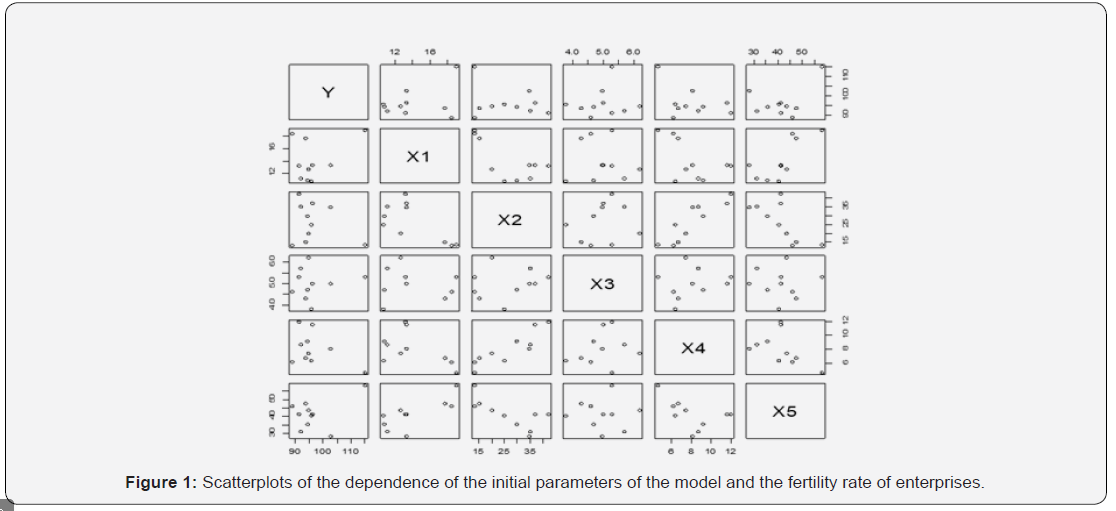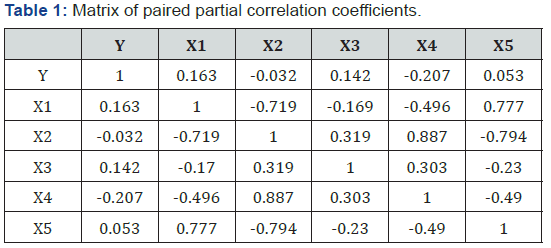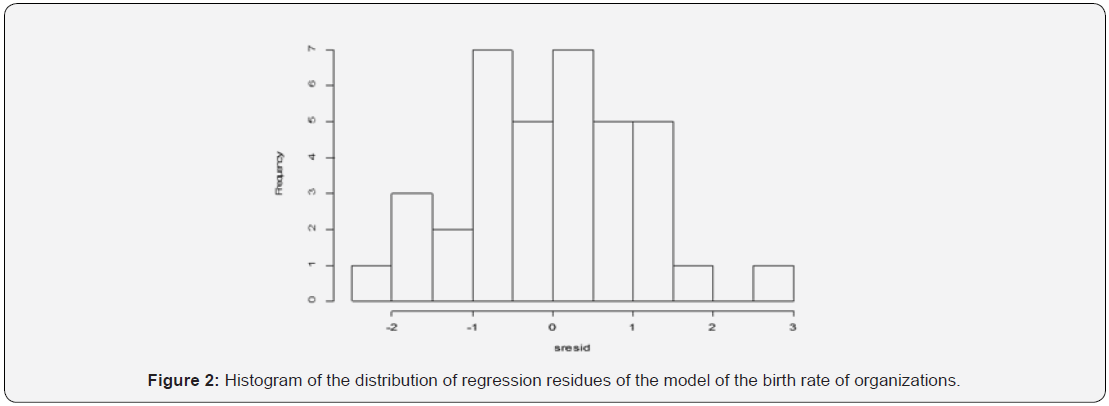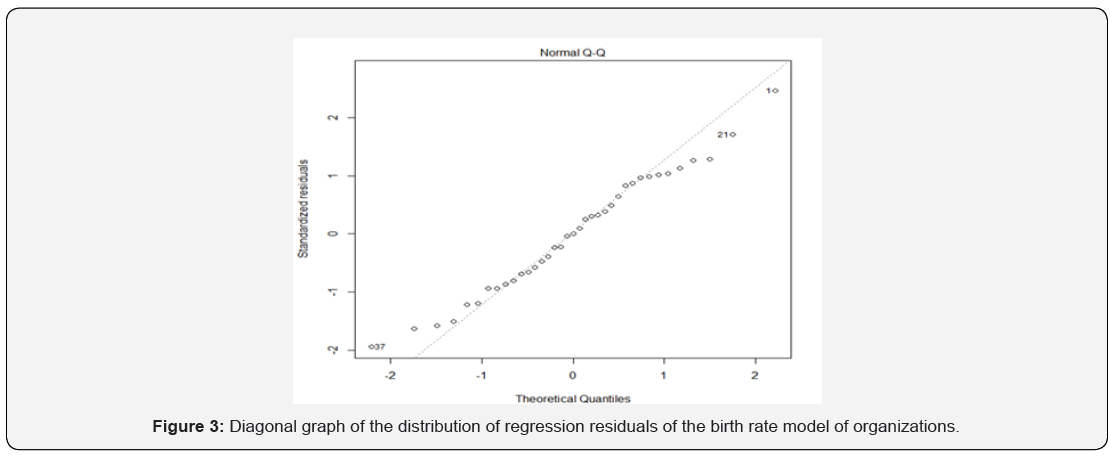Modeling the Birth Rate of Single-Industry Towns on the Basis of Indicators of Business Demography-Juniper Publishers
Annals of Social Sciences & Management Studies-Juniper Publishers
Introduction
Modern economic relations are practically based on the processes of creation of new enterprises [1-3]. The synchronicity of the economic system, its dynamic stability is provided by the economic mechanism, pursuing common objectives – the creation/birth of new business structures [4,5]. Growing indicators of demographic processes in business statistics show that everything is going right. Tracking demographic processes allows you to get an idea of the real processes taking place in the economy, to assess how sustainable entrepreneurship is in the current conditions: the processes of creating a really new business or the growth of the number of enterprises are the result of restructuring, etc. [6,7]. For example, the analysis of the dynamics of the number of operating enterprises – legal entities and its impact on the level of production should be carried out in close connection with the method of their formation. The formation of new enterprises creates new production capacities and jobs and, therefore, has a greater impact on the improvement of the social situation of the region than the restructuring of existing enterprises [8].
Methodology (materials used, description of the subject, methods and techniques of research).
The main purpose of multiple regression is to build a model with many factors, determining the impact of each of them separately, as well as their cumulative impact on the modeled indicator. Regression equations characterize the isolated influence of a factor on the result, because other factors are fixed at a constant level. The effects of other factors are attached to the free term of the multiple regression equation. They can be compared with each other and respectively to rank the factors according to their impact on the result.
The value of the multiple correlation index ranges from 0 to 1 and must be greater than or equal to the maximum pair correlation index: The closer the value of the multiple correlation index to 1, the closer the connection of the effective feature with the whole set of factors under study. Comparing the indices of multiple and pair correlation, it can be concluded that it is reasonable (the value of the index of multiple correlation is significantly different from the index of pair correlation) to include this or that factor in the regression equation.
Findings
To construct a multiple regression model of the birth rate of enterprises, the following characteristics were selected:
Y - fertility organizations 1000 organizations;
X1 - the number of people with monetary incomes below the subsistence minimum, million people (the more people with low income, the more often they are visited by the idea of opening a business to improve the financial situation);
X2 - loans, deposits and other placed funds provided to organizations, individuals and credit organizations, trillion rubles (for loans people can start business);
X3 - entrepreneurial intentions, % (people intending to start a business are involved in the creation of new organizations);
X4 - the overall level of entrepreneurial activity, in % (the higher the overall level of entrepreneurial activity, the more people open their businesses);
X5 - the number of victims of industrial accidents, thousand people (after industrial injuries, people often think about opening their own, safer business).
Graphs and subsequent calculations of the model parameters are obtained in the R (CRAN) environment. The graph of pairwise scatterplots is shown in (Figure 1) (Table 1).


We construct a regression model by step-by-step elimination of factors [9,10]. At the initial (zero) stage, a model of the dependence of the effective feature on all factor variables is constructed, the parameters of the initial model and their estimates are presented in (Table 2).
The resulting model is as follows:
Y = 54.86+0.638X1+1.347X2+1.456X3-4.809X4+0.694X5,
where:
Y - fertility organizations 1000 organizations;
X1 - population with monetary income below the subsistence minimum, million people;
X2 - loans, deposits and other placements provided to organizations, individuals and credit institutions, RUB trillion;
X3 - entrepreneurial intentions, in %;
X4 - General level of entrepreneurial activity, in %;
X5 - number of victims of industrial accidents, thousand people.

According to (Table 2), the regression equation obtained is very high significant by Fisher’s F-test at 95% confidence level (p-value=0.00018<0.001), all regression coefficients except X3 are significant at 95% confidence level. However, due to the insignificance of the regression coefficient X3, this equation does not allow to predict the fertility rate of enterprises. At the next stage of step-by-step construction of the model and to calculate the parameters of the regression equation for the fertility rate of enterprises, which would allow to obtain its forecast estimates, the factor characteristic X3 (entrepreneurial intentions, in %) should be excluded from the initial characteristics and the parameters of the regression equation should be re-evaluated. The obtained regression coefficients of the new equation, their standard errors and the results of their significance evaluation are presented in (Table 3).

The resulting equation of the model of the birth rate of enterprises can be written as follows:
Y = 61.1+0,67X1+1,37X2-4,79X3+0,69X4, where:
Y - fertility organizations 1000 organizations;
X1 - population with monetary income below the subsistence minimum, million people;
X2 - loans, deposits and other placements provided to organizations, individuals and credit institutions, RUB trillion;
X3 - General level of entrepreneurial activity, in %;
X4 - the number of victims of industrial accidents, thousand people.
The calculated value of the F-test is 8.211, p-value=0.0001 < 0.001, the equation is very high significant according to Fisher’s F-test at the 95% confidence level. Based on (Table 3) all regression coefficients in the model are significant at the 95% confidence level, which makes it possible to use the obtained model to predict the birth rate of the enterprise. Nevertheless, according to the multiple coefficient of determination, the model allows to describe 50.65% of the change in the birth rate of enterprises, which, in the author’s opinion, is due to its high fluctuation in the existing, for the period under review, and characterized by increased instability of the economic development conditions and economic expectations of persons engaged in or planning to engage in entrepreneurial activity. Standardized regression coefficients (beta-coefficients) of the obtained model are presented in (Table 4).


Thus, the size of the amount of loans, deposits and other placed funds provided to organizations, individuals and credit institutions affects the birth rate of organizations to the greatest extent, while the population with incomes below the subsistence minimum is the smallest. The increase in the amount of loans, deposits and other placements provided to organizations, individuals and credit organizations by 1% leads to an increase in the birth rate by 3.23%. The increase in entrepreneurial activity by 1% causes a decrease in the birth rate of organizations by 2.28%. The increase in the number of victims of industrial accidents by 1% causes an increase in the birth rate by 1.13%. The increase in the number of people with incomes below the subsistence minimum corresponds to an increase in the birth rate of organizations by 0.48%. The histogram of the distribution of regression residues is shown in (Figure 2). The actual and theoretical distribution of the regression residuals is shown in (Figure 3). Analysis of graphs allows us to conclude that the distribution of regression residues corresponds to normal.

Conclusion
The proposed data can be used both individually and jointly as part of more complex forecasts and models (depending on the specific economic conditions and the possibility of identifying the included parameters) for decision-making in the field of optimizing the state economic policy to support and stimulate entrepreneurial activity in single-industry towns.
https://juniperpublishers.com/asm/ASM.MS.ID.555642.php
For More Articles in Annals of Social Sciences & Management studies Please Click on: https://juniperpublishers.com/asm/index.php
For More Open Access Journals In Juniper Publishers Please click on: https://juniperpublishers.com/index.php
For more queries Juniper publishers please click on: https://www.quora.com/Is-Juniper-Publisher-a-good-journal-to-publish-my-paper



Comments
Post a Comment